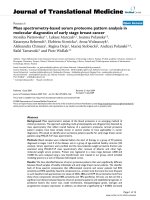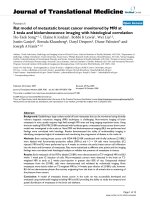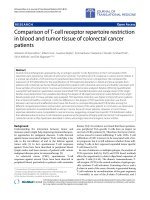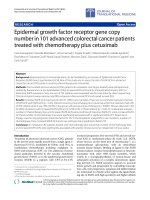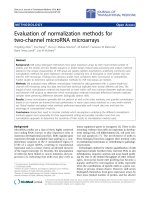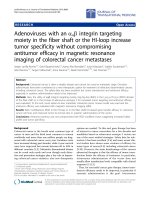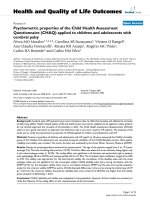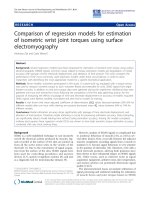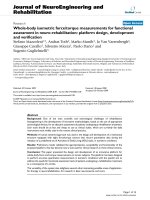báo cáo hóa học: "Whole-body isometric force/torque measurements for functional assessment in neuro-rehabilitation: platform design, development and verification" pot
Bạn đang xem bản rút gọn của tài liệu. Xem và tải ngay bản đầy đủ của tài liệu tại đây (1.16 MB, 15 trang )
BioMed Central
Page 1 of 15
(page number not for citation purposes)
Journal of NeuroEngineering and
Rehabilitation
Open Access
Research
Whole-body isometric force/torque measurements for functional
assessment in neuro-rehabilitation: platform design, development
and verification
Stefano Mazzoleni*
1
, Andras Toth
2
, Marko Munih
3
, Jo Van Vaerenbergh
4
,
Giuseppe Cavallo
5
, Silvestro Micera
1
, Paolo Dario
1
and
Eugenio Guglielmelli
5
Address:
1
ARTS Lab, Scuola Superiore Sant'Anna, Pisa, Italy,
2
Department of Manufacturing Engineering, Budapest University of Technology and
Economics, Budapest, Hungary,
3
Laboratory of Robotics and Biomedical Engineering, Faculty of Electrical Engineering, University of Ljubljana,
Ljubljana, Slovenia,
4
Laboratorium for Neuro- and Psychophysiology, Katholieke Universiteit Leuven, Belgium and
5
Laboratory of Biomedical
Robotics & EMC, Università Campus Bio-Medico, Rome, Italy
Email: Stefano Mazzoleni* - ; Andras Toth - ; Marko Munih - ; Jo Van
Vaerenbergh - ; Giuseppe Cavallo - ; Silvestro Micera - ;
Paolo Dario - ; Eugenio Guglielmelli -
* Corresponding author
Abstract
Background: One of the main scientific and technological challenges of rehabilitation
bioengineering is the development of innovative methodologies, based on the use of appropriate
technological devices, for an objective assessment of patients undergoing a rehabilitation treatment.
Such tools should be as fast and cheap to use as clinical scales, which are currently the daily
instruments most widely used in the routine clinical practice.
Methods: A human-centered approach was used in the design and development of a mechanical
structure equipped with eight force/torque sensors that record quantitative data during the
initiation of a predefined set of Activities of Daily Living (ADL) tasks, in isometric conditions.
Results: Preliminary results validated the appropriateness, acceptability and functionality of the
proposed platform, that has become now a tool used for clinical research in three clinical centres.
Conclusion: This paper presented the design and development of an innovative platform for
whole-body force and torque measurements on human subjects. The platform has been designed
to perform accurate quantitative measurements in isometric conditions with the specific aim to
address the needs for functional assessment tests of patients undergoing a rehabilitation treatment
as a consequence of a stroke.
The versatility of the system also enlightens several other interesting possible areas of application
for therapy in neurorehabilitation, for research in basic neuroscience, and more.
Published: 30 October 2009
Journal of NeuroEngineering and Rehabilitation 2009, 6:38 doi:10.1186/1743-0003-6-38
Received: 18 August 2008
Accepted: 30 October 2009
This article is available from: />© 2009 Mazzoleni et al; licensee BioMed Central Ltd.
This is an Open Access article distributed under the terms of the Creative Commons Attribution License ( />),
which permits unrestricted use, distribution, and reproduction in any medium, provided the original work is properly cited.
Journal of NeuroEngineering and Rehabilitation 2009, 6:38 />Page 2 of 15
(page number not for citation purposes)
Background
One of the main scientific and technological challenges of
rehabilitation bioengineering is the development of inno-
vative methodologies, based on the use of appropriate
technological devices, for the assessment of the motor
output from patients undergoing a rehabilitation treat-
ment. Such tools should be as fast and cheap to use as
clinical scales, which are currently the daily instruments
most widely used in the routine clinical practice.
In this work, our interest is focused on the development
of mechatronic platform for the assessment of stroke
patients using force/torque (F/T) measurements in iso-
metric conditions.
Stroke is the third leading cause of death in most devel-
oped countries [1] and the leading cause of long term dis-
ability [2,3].
During the last decade, different research studies focused
on the identification of milestones characterizing the
motor rehabilitation process [4] and predictive markers of
functional recovery from stroke [5].
A measure of functional abilities may be obtained by
using functional assessment scales that include the ability
to perform Activities of Daily Living (ADL). These scales
are commonly used to monitor the patients' progress [6-
8], but present several limitations due to their subjective
nature. The development of methods and devices for
objective measures of patients' motor output represent a
need in the rehabilitation domain.
In the last decade, different types of dynamometer have
been developed, but only few simple devices for isometric
measurements came on to the market.
Different devices have been already developed: commer-
cially available dynamometers equipped with force/
torque (F/T) sensors are able to record the forces and tor-
ques that are produced at contact points between the
human body and the environment. From the biomechan-
ical point of view, they provide information on the joint
forces and torques exerted by the patient., but show three
main limitations: they (i) impose artificial motions or
loadings on the subject, (ii) can measure only one degree-
of-freedom (DOF) F/T data at the same time and (iii) pro-
vide only a little information about the underlying physi-
ological and neural mechanisms.
In order to overcome the above mentioned drawbacks,
our approach focuses on the changes in repetitively meas-
ured F/T patterns recorded during the initiation of differ-
ent ADL tasks using isometric contractions: our
hypothesis is that a mechatronic device based on such
approach can track the course of recovery in stroke and
thus determine the effectiveness of applied rehabilitation
treatments.
Recently, the application of robotics and mechatronic
technology to functional assessment and motor therapy
has been introduced in neurological rehabilitation [9,10]
with very encouraging early clinical results [11].
To date, the use of voluntary isometric contractions for
assessment purposes in humans was applied to single
joints [12,13] and groups of muscles [14].
The neurophysiological assumptions which inspired the
motivations for the design and the development of the
proposed mechatronic platform rely on the recent neuro-
scientific findings about the forward model as internal
representation of the causal relationship between sensori-
motor signals and motor commands [15-18].
In the first days after a stroke, the amplitude of any possi-
ble movement is very limited: the basic idea is to perform
isometric measurement of functional directed move-
ments. The choice of using an isometric approach is based
on the discovery that imagination and initiation of the
task have the same functional properties as performing
the task [19-26].
Some authors have proposed the use of isometric forces
and torques for the analysis of the intention to perform a
given task [27]. This approach can detect some sensorim-
otor representations in the early phases after a stroke
[28,29]. This methodology, based on the movement initi-
ation, can allow the verification of the existence of a still
unimpaired or damaged forward model for a specific
functional task. This model maps motor commands onto
their corresponding sensory consequences and will adapt
itself according to new dynamical situations. After a
stroke, in addition to the reduced or lost neuromuscular
voluntary activation, different sensorimotor functions
may be impaired: spasticity, co-contraction and muscle
synergies as well as compensation may interfere with the
quality of the motor tasks.
The parameters which measure the possible motor recov-
ery could be implemented in order to reveal day by day
changes in the motor system.
The forward model can be preserved, but the motor out-
put is reduced or disorganized, either may show modifica-
tions through an adapted motor output. It can happen
that the forward model fails or is even abolished, leading
to negative consequences for the movements smoothness
[26,30].
The possible improvement of functional performance can
be assessed using ADL tasks, which represent motor rou-
Journal of NeuroEngineering and Rehabilitation 2009, 6:38 />Page 3 of 15
(page number not for citation purposes)
tines with associated defined forward models. Moreover,
their motor patterns are expected to be highly repeatable
and predictable.
Since the main objective of our approach is to find a quan-
titative functional assessment during rehabilitation, the
implementation of synchronous multichannel F/T data
recordings is essential.
In this paper a diagnostic device which has the capability
of measuring multichannel F/T data in isometric condi-
tions from different body locations, starting from natural
positions is presented. There are no similar commercially
available isokinetic or isometric devices on the market
that meet previous requirements.
Therefore, the diagnostic device here presented represents
an original contribution to the modern challenges of
functional assessment of motor recovery to be used in
neurorehabilitation clinical practice.
A human-centered design methodology, which will be
presented in the next section together with the functional
specifications, was chosen as methodological approach
for the development of the proposed diagnostic device.
In conclusion, the research presented in the paper was
aimed at developing a diagnostic device and an innova-
tive protocol for the functional assessment of post-stroke
patients, based on multichannel F/T measurements on the
whole body, recorded during ADLs tasks in isometric con-
ditions.
Methods
Basic requirements
The neuroscientific findings described in the previous sec-
tion form the basis for the design of an innovative diag-
nostic device. An interactive design process involved
rehabilitation specialists and engineers toward the defini-
tion of basic requirements for such device:
• capability of recording F/T data from the hand, from
the arm, the trunk, the seat, and from the foot of a
patient seated on a standard wheelchair;
• easy and quick adjustments for the different anthro-
pometrical characteristics of the population;
• to be used on both the right and left body side;
• requiring a minimum physical effort and time to the
operator;
• capability of recording measurements in three differ-
ent postures;
• to be a modular system.
Functional specifications
The main objective of recording isometric F/T measure-
ments is to obtain quantitative assessment during stroke
rehabilitation. Every isometric measurement is used to
determine the actual motor status of the patient. A
detailed clinical protocol was developed in order to per-
form F/T measurements on post-stroke patients [31].
Six different ADL tasks with a varying complexity were
used for such purpose. An initial list of 42 possible tasks
were selected consulting reference textbooks [32-35].
Because of time constraints (30 minutes for each measur-
ing cycle), six tasks were finally selected from the 42 for-
merly proposed. Each task demonstrates features of a
reached functional milestone during the recovery from
stroke.
Post-stroke patients have been invited to perform them in
a prescribed order. For each task, five different recordings
were performed: on a monitor placed in front of him/her,
the patient watches a video showing the movement asso-
ciated to each ADL task to be performed (recording #1).
Secondly he is asked to mentally imagine and reproducing
it with open eyes (recording #2). Finally, after the appear-
ance of a green light on the monitor, he is asked to repeat
the task for three times, trying to exert the forces at a com-
fortable level (recording #3, recording #4 and recording
#5).
On the basis of the measuring protocol, the following
functional specifications were chosen. Patients were
seated in a special designed wheelchair and driven into an
anthropometrical adaptive measuring instrument. Appro-
priate size accessories and device settings were also used to
ensure that the error in the anatomical angles is minimal,
as well as to keep the handling complexity of the diagnos-
tic device on a tolerable level for the operating physiother-
apist.
Three different positional settings, described in the fol-
lowing section, were chosen for the measurements: they
represent a trade-off between a good approximation of
natural postures and the anthropometric characteristics of
the subject. This choice assures sufficient conditions of
repeatability to the measurements.
A clinical assessment was performed through the Fugl-
Meyer Scale (Lindmark adaptation), the Motor Assess-
ment Scale and the Stroke Impact Scale. The physiothera-
pists used a Portable Digital Assistant (PDA) in order to
record the scores for each assessment scale and patients'
functional recovery by using natural language descrip-
tions.
Journal of NeuroEngineering and Rehabilitation 2009, 6:38 />Page 4 of 15
(page number not for citation purposes)
To assure an high reproducibility during the entire period
of data acquisition in clinical trials it was necessary to
measure a large number of patients with the same device
and in the same anatomical starting position.
The data acquisition system has recorded isometric F/T
data from:
• the trunk (at the patient's back),
• the lower trunk (at the patient's fundament: the cor-
responding F/T sensor is placed under the wheelchair's
seat plate),
• the impaired lower limb,
• the impaired foot and toe,
• the impaired middle finger, index finger and thumb.
ADL tasks to be performed during isometric F/T measure-
ments are listed in the following sequence, together with
the corresponding object:
ADL task #1
Drinking a glass (no reaching): the arm is placed close to
the body, close to the mid line, the position of the foot is
standard, the fingers of the hand are prepared for a cylin-
drical grasp. Object: glass placed close to the hand.
ADL task #2
Turning a key: the starting position is the same as for
grasping the glass. Object: a key in a lock located in front
of the hand. The key should be oriented horizontally in
the lock.
ADL task #3
Taking a spoon: the starting position is the same as for
grasping the glass. The reaching movement towards the
spoon is measured. The position of the foot is standard.
Object: a spoon is placed a bit higher than the glass, on
the side of the back of the hand.
ADL task #4
Lifting a bag: the starting position of the arm is at the side
of the body, the elbow is in a natural position (slightly
flexed), the position of the hand and the foot are stand-
ard, the fingers of the hand are prepared for a cylindrical
grasp. Object: a bag placed on the ground.
ADL task #5
Reaching for a bottle: the starting position is an almost
extended arm over the midline. The starting position of
the hand is the same as for drinking the glass. The position
of the foot is slid backward, and the back should be leaned
forward. Object: a bottle placed in front of the hand.
ADL task #6
Bringing the bottle to the other side: the starting positions
of the arm, hand, and the foot are the same as for reaching
for a bottle. Object: a bottle placed in front of the affected
upper limb at arm reach distance.
As mentioned earlier, the platform has three positional
settings for the patient according to the six selected ADL
tasks to be performed during isometric F/T measurements:
position 1 covers ADL task #1, ADL task #2 and ADL task
#3, position 2 is related to ADL task #4, and position 3
covers ADL task #5 and ADL task #6.
The above functional specifications have been included
into the design methodology presented in the following
section.
Human-centered design methodology
A human-centered mechatronic design approach has been
followed by starting from anthropometrical considera-
tions and iteratively refined in a tight debate with clini-
cians and end-users (i.e., therapists, patients).
Simulations, mock-ups and two different prototypes of
the platform have been extensively used to obtain direct
feedbacks from end-users and to enable experimental pre-
liminary tests in the real application domain.
The proposed method for isometric F/T measurements
requires fixed, very stiff, anatomically standard and, at the
same time, repeatable individual setting of the device for
each patient in order to ensure reproducibility, reliability
and good precision in the isometric measurements.
Design requirements of the platform arose from three dif-
ferent areas. Firstly, standardisation of the measurement,
secondly safety standards, as well as medical certification
requirements. Finally, space limitations in hospitals
regarding the room where the device was used and the
location where the wheelchairs was stored when they are
not in use, were taken into account. Standardisation of the
postures and measurement procedure, including a cali-
bration routine, assured reliability and validity to the
recorded F/T measurements.
As a reference position, the user is seated on a wheelchair
at height of 580 mm from the floor of the platform and
whose back is 330 mm back from the rear side of the
device.
In this configuration, isometric contractions in two refer-
ence postures of the lower extremities can be performed
by using the proposed platform (Figure 1). In the former,
the user is seating in a neutral posture.
This position is typical for the initiation of most common
tasks, such as lifting or grasping an object: it is the starting
Journal of NeuroEngineering and Rehabilitation 2009, 6:38 />Page 5 of 15
(page number not for citation purposes)
position for ADL task #1, ADL task #2, ADL task #3 and
ADL task #4. The latter takes into account a different pos-
ture which enables the user to move the trunk forward
and the feet backward. Starting from this position, other
tasks, such as a forward reaching tasks, can be performed:
it is the starting position for ADL task #5 and ADL task #6.
The anthropometrical data of the European population
was studied [36]. The ergonomic study was performed
through CAD simulations (Pro/Engineer): a 3D manne-
quin model, created by using the Mannequin Pro tool, has
been inserted into the CAD environment with the aim of
(i) simulating the different postures according to the gen-
der and percentile and (ii) fitting the design of the plat-
form to the anatomical positions accordingly.
The results of this study enlightened the possibility of
implementing a limited number of discrete settings on the
platform, henceforth named S (Small), M (Medium) and
L (Large), corresponding to the values of the 25th percen-
tile female (S size), the mean of the 50th percentile male
and 50th percentile female (M size), and the 75th percen-
tile male (L size).
Therefore, the device can be set without error to the above
mentioned percentiles of the population, which repre-
sents a vast majority of the population.
Sample CAD models used in the ergonomic study (top) and the two corresponding selected postures for lower extremities and feet (bottom)Figure 1
Sample CAD models used in the ergonomic study (top) and the two corresponding selected postures for
lower extremities and feet (bottom).
Journal of NeuroEngineering and Rehabilitation 2009, 6:38 />Page 6 of 15
(page number not for citation purposes)
The adjustability of the device to the three discrete patient
sizes was implemented. To minimize the error in the ana-
tomical angles to be set at each of the six ADLs, as well as
to keep the handling complexity of the diagnostic device
on a tolerable level for the operating physiotherapist, the
patients recruited for the isometric F/T measurements
were classified into three groups according to their height.
During the measurements the appropriate size accessories
and device settings were used. The size groups were
denoted by the S, M, L labels and colour codes were used
in order to make the operations easier (Table 1).
As a consequence of the mentioned approach, the set of
the anatomical angles in position 1, position 2 and posi-
tion 3 was fixed for any patient size. These angles, except
those in neutral positions are listed in Table 2. The calcu-
lated deviation from the ideal anatomical angles
remained in the range ± 0.5°.
The anthropometrical and ergonomic design approach,
by identifying only a limited number of adjustments
required to the therapist, clearly simplified the design and
the development of the overall system, presented in the
following section, and represents an advantage in terms of
setup time.
The Alladin Diagnostic Device (ADD)
The design choice was to develop a simple and low cost
platform for clinical applications: in principle, every
degree of freedom in the platform can be actuated for the
adjustments and for transforming it into a robotic system,
if necessary. This could be done without altering radically
the present design.
The main objective of the mechatronic platform, hence-
forth named Alladin Diagnostic Device (ADD), here pre-
sented is to perform valid and reliable isometric F/T
measurements at stroke patients during the execution of
the six ADL tasks. The cycle time for a single isometric
force torque measurements (including measurement of
the six ADL tasks) was 30 minutes. No significant time dif-
ference between healthy controls and patients was found.
The ADD has to provide repeatable and accurate measure-
ments: given this important requirement, the patients
were precisely positioned to the same set of ADL positions
for each recording.
The standardization achieved both in terms of the
mechanics of the device, the F/T sensor unit, the measure-
ment control software and the unambiguous guidelines
on the operation of the device have resulted in high repro-
ducibility and comparability of the F/T measurements.
Since April 2004, a complete product design and develop-
ment cycle, including a computer aided design, the devel-
opment of three early prototypes and the feedback from
the testing, were implemented. Refinement and detailing
of the conceptual design was a natural result of this cyclic
process.
The choice of the sensors was leaded by the measurement
input ranges which was derived partly on the basis of
existing references about typical data on human subjects
[37-41], and partly on the basis of preliminary measure-
ments. Eight 6-axis F/T commercial sensors were respec-
tively installed behind the trunk, below the posterior, at
the affected lower arm, at the affected thumb, index and
middle finger, at the affected foot and toe, output detailed
data on the ADL tasks to be performed. Table 3 shows the
basic characteristics of the 6-axis F/T sensors (50M31A-
I25, 67M25A-I40, 90M40A-I50, 45E15A-U760, JR3 Inc.,
Woodland, USA).
All operating instructions are presented on a screen in
front of the patient. The combined output of 48 channels
representing the x, y, z components of F/T signals for all
eight sensors are recorded using a sampling frequency of
100 Hz. The diagnostic device includes the following
main units (Figure 2):
1. Accessory storage board
2. Transit lying wheelchair
3. Monitor for the patient
4. Podium
5. Trunk Device
6. Foot Device
7. Arm Device
8. Finger Device
9. Seat Device
The Finger Device, the Arm Device, the Trunk Device, the
Seat Device and the Foot Device are shown in Figure 3, 4,
5, 6 and 7 respectively. A customized software has been
developed in order to manage all the functionalities pro-
Table 1: Definition of patients' division into three groups,
according to their height.
Label Colour code Height (h)
S Yellow h < 1625 mm
M Green 1625 mm < h < 1751 mm
LBlue h > 1751 mm
Journal of NeuroEngineering and Rehabilitation 2009, 6:38 />Page 7 of 15
(page number not for citation purposes)
vided by the ADD, including the recording and exchange
of different types of data between the different modules.
The main data to be collected and managed are:
• Patient data and case history
• Standard Outcome Measure (SOM)
• Natural language descriptions of the patient's status
• Voice records of the descriptions
• F/T measurement records from ADL tasks
All data, after having been collected, are uploaded to a
local database. The graphical user interface (Figure 8)
Table 2: The values of anatomical angles in Position 1, Position 2 and Position 3.
Articular movement Position 1 Position 2 Position 3
Shoulder abduction 15 5 0
Shoulder flexion 50 0 100
Shoulder extension 0 7 0
Shoulder internal rotation 45 0 45
Elbow flexion 35 12 20
Thumb abduction 50 50 50
Finger metacarpophalangeal flexion 15 20 15
Finger proximal interphalangeal flexion 20 0 20
Finger distal interphalangeal flexion 20 20 20
Lumbar-thoracic flexion 0 0 30
Lumbar-thoracic rotation 0 0 20
Lumbar-thoracic lateral flexion 0 0 18
Hip flexion 90 90 90
Knee flexion 90 90 110
Ankle dorsiflexion 0 0 8
Toe metatarsophalangeal flexion 0 0 7
Table 3: 6-axis F/T sensors: basic characteristics.
Qty Model Description Lateral forces (Fx,
Fy) [N]
Axial force (Fz) [N] Torques (Tx, Ty,
Tz) [Nm]
Dimensions [mm]
3 50M31A-I25 150N8 Type-H(and) 150 300 8 Ø 50 × 31
1 67M25A-I40 150N10 Type-A(rm) 150 200 10 Ø 67 × 35
1 90M40A-I50 250N20 Type-B(ack) 250 250 20 Ø 90 × 40
1 45E15A-U760
1200N120
Type-S(eat) 600 1200 120 Ø 114 × 40
1 90M40A-I50 400N25 Type-F(oot) 400 800 25 Ø 90 × 40
1 50M31A-I25 150N8 Type-T(oe) 150 300 8 Ø 50 × 31
Journal of NeuroEngineering and Rehabilitation 2009, 6:38 />Page 8 of 15
(page number not for citation purposes)
offers different functionalities, such opening a patient
record, starting a new session of measurements, creating a
new patient record, editing and creating an user's profile,
synchronizing with the global DB, system settings adjust-
ment and remote assistance. Four different types of users
were identified (ADD physiotherapist, Natural language
physiotherapist, Principal Investigator and System admin-
istrator): for each user profile an access rights policy was
defined.
Different tests were performed in order to investigate the
measurements characteristics of the device: time and fre-
quency analysis of the force series and their derivatives led
to the application of appropriate pre-processing data fil-
tering [42]
Several young volunteers participated in a preliminary
testing aimed at verifying the output of the proposed iso-
metric procedure and improving the design choices.
Results
The results from the clinical trials, started in February
2005 and ended in September 2006, whose report is not
The components of the platform: 1) Accessory storage board, 2) Transit lying wheelchair, 3) Monitor for the patient, 4) Podium, 5) Trunk Device, 6) Foot Device, 7) Arm Device, 8) Finger Device, 9) Seat DeviceFigure 2
The components of the platform: 1) Accessory storage board, 2) Transit lying wheelchair, 3) Monitor for the
patient, 4) Podium, 5) Trunk Device, 6) Foot Device, 7) Arm Device, 8) Finger Device, 9) Seat Device.
The Finger DeviceFigure 3
The Finger Device.
The Arm DeviceFigure 4
The Arm Device.
Journal of NeuroEngineering and Rehabilitation 2009, 6:38 />Page 9 of 15
(page number not for citation purposes)
the aim of this paper, demonstrate that the device per-
forms all operations in accordance with system require-
ments and functional specifications.
Patients were recruited following these inclusion criteria:
1) hemiparesis due to stroke, 2) the brain impairment
must be provided by CT or MRI, 3) minimum age is 18
years, 4) the subject must be suitable to endure physical
load during the measurements, 5) the subject must be
cooperative, 6) signed informed consent. Exclusion crite-
ria were: 1) restricted disposing capacity or legal capacity,
2) prisoner, 3) movement or other disorder that makes it
impossible for the patient to sit calmly during the treat-
ment, 4) skin problem where use of an orthosis is contra-
indicated, 5) patients shorter than 1530 mm and taller
than 1870 mm, 6) patients with a weight over 110 kg.
The centres participating in the multi-centre clinical trials
were:
• Algemeen Ziekenhuis Maria Middelares Sint-Jozef
Hospital (AZMMSJ), Gent, Belgium
• Adelaide & Meath Hospital (AMNCH), Tallaght,
Dublin, Ireland
• Szent János Hospital, Budapest, Hungary
All three clinical centres obtained the approval of the rel-
evant ethics committees for performing the trials. An
informed consent was obtained from each participating
subject, who was measured and assessed twice a week for
the first two months period and once a week during four
consecutive months. No adverse events occurred during
the trials.
Table 4 shows the comparison among the scores of Fugl-
Meyer (Hand section), Motor Assessment Scale ("Hand
movements" and "Advanced Hand Activities" sections),
Stroke Impact Scale (Hand function) scores and the mean
value of force resultant vector in three hand sensors
(Thumb, Index, Middle Finger), "Drinking" task, attempt
#4, from 10 post-stroke patients.
As the scores of the different scales changes, the values of
the recorded mean force resultant vector change. This is
mainly remarkable in the Fugl-Meyer scores.
Some preliminary results from a normal control subject
and a pathological subject are here presented. The choice
The Trunk DeviceFigure 5
The Trunk Device.
The Seat Device: rear view (a), lateral view (b)Figure 6
The Seat Device: rear view (a), lateral view (b).
The Foot DeviceFigure 7
The Foot Device.
Journal of NeuroEngineering and Rehabilitation 2009, 6:38 />Page 10 of 15
(page number not for citation purposes)
of the task and the sensors is based on the results of data
mining algorithms applied to the pre-processed data [43].
Let's consider the task "Drinking" in a healthy control
(male, 45 years old, right dominant hand, measurement
of the left side) and in a pathological subject (male, 43
years old, right dominant hand, right side of hemiparesis,
date of stroke 15/12/2005, measurement on the right
side), 25 days and 131 days following the stroke onset.
The number of samples from force measurements shown
in Figure 6, 7 and 8 is 5400: as already stated, the sample
frequency for data acquisition is 100 Hz, therefore the task
lasts 5.4 seconds.
Figure 9 shows the force measurements from the thumb
in the normal control (top plot), in the hemiparetic
patient, 25 days following the stroke onset (middle plot)
and 131 days following the stroke onset (bottom plot). In
the healthy control, positive values in the Fx-direction can
be observed. In normal circumstances, for a grasping
movement, the thumb will be brought to the point where
the index and the middle finger touch each other. In the
diagnostic device, the thumb is fixated on the same height
as the index finger. This causes a downwards movement of
the thumb when the subject grasps the glass to drink. The
positive values in Fy-direction means that the subject
moves the thumb forwards when he positions the fingers
around the glass to drink. The positive values for Fz-direc-
tion points out that the subject grasps the glass to drink.
The force measurement from the thumb recorded 25 days
following the stroke onset show negative values on the x-
axis: the force is directed in the opposite direction than the
motor performance in the normal control subject, point-
ing out that the subject moves the thumb upwards to
bring the glass to the mouth, instead of moving down-
wards. The negative values observed along the Fy-direc-
tion mean that the subject pushes the thumb forwards to
bring the glass to the mouth. The positive values along the
z-axis allow to conclude that the subject tries and grasps
the glass to drink. The force is exerted in advance than the
normal control subject and it lasts till to the end of the
attempt.
The main menu of the graphical user interfaceFigure 8
The main menu of the graphical user interface.
Journal of NeuroEngineering and Rehabilitation 2009, 6:38 />Page 11 of 15
(page number not for citation purposes)
Table 4: Comparison among Fugl-Meyer (Hand section), Motor Assessment Scale ("Hand movements" and "Advanced Hand
Activities"), Stroke Impact Scale (Hand function) scores and mean value of force resultant vector from three hand sensors (Thumb,
Index, Middle Finger), "Drinking" task, attempt #4, in ten post-stroke patients.
Subject Week Mean [N] FM
1
MAS
2
SIS
3
Subject_1 TCD-063 2 4.28296 17 10 (s05) N/A
27 4.31637 21 11 (s31) 16 (s16)
37 4.52127 19 11 (s41) 16 (s41)
Subject_2 TCD-067 3 12.2230 14 9 (s05) 20 (s05)
9 15.2048 17 12 (s11) N/A
27 25.7825 21 12 (s29) 5 (s05)
Subject_3 AHS-072 8 1.99971 17 8 (s10) 5 (s08)
16 1.23859 18 9 (s20) 5 (s16)
27 4.25887 18 9 (s30) 5 (s27)
Subject_4 AHS-023 3 8.493 20 8 (s07) 5 (s03)
13 15.799 19 7 (s16) 5 (s13)
22 15.075 21 9 (s25) 5 (s22)
Subject_5 TCD-027 4 1.25301 3 0 (s05) 5 (s02)
17 1.90167 9 8 (s19) 5 (s05)
26 7.31028 21 10 (s23) 8 (s23)
Subject_6 NIMR-076 4 7.68038 2 0 (s02) 5 (s02)
23 6.93772 7 6 (s26) N/A
35 8.37792 21 6 (s38) 17 (s38)
Subject_7 AHS-022 3 3.6903 21 8 (s06) 5 (s03)
15 7.9402 19 10 (s19) 5 (s15)
23 4.7744 20 6 (s99) 5 (s23)
Subject_8 AHS-012 4 3.69191 18 N/A 5 (s04)
12 5.26977 19 5 (s15) 5 (s12)
21 4.77444 21 6 (s24) 13 (s21)
Subject_9 AHS-011 4 8.56937 16 5 (s09) 5 (s04)
15 21.3752 15 5 (s18) 5 (s15)
Journal of NeuroEngineering and Rehabilitation 2009, 6:38 />Page 12 of 15
(page number not for citation purposes)
The force measurement from the thumb recorded 131
days following the stroke onset show the positive values
on the x-axis, same direction as the motor performance in
the healthy control, meaning that the subject moves the
thumb downwards to bring the glass to the mouth, even
if the force reaches the zero at about the half of the meas-
urement, before still rising to positive values. The negative
values observed along the y-axis point out that the subject
pushes the thumb forwards to bring the glass to the
mouth. The positive values along the z-axis mean that the
subject tries and grasps the glass to drink. The force is
exerted in advance than the normal control subject and it
lasts till to the end of the attempt.
Figure 10 and 11 show the force measurements in the nor-
mal control (top plot), in the hemiparetic patient, 25 days
following the stroke onset (middle plot) and 131 days fol-
lowing the stroke onset (bottom plot) from the index fin-
ger and the middle finger respectively. Similar
observations can be drawn for such measurements.
A large set of features characterizing the clinical recovery
were extracted from the data according to the preliminary
results from data mining techniques [42] in order to track
the recovery process through milestones and to foresee
the rehabilitation outcome through predictive markers:
they are presented in a companion paper.
Finally, a study about the impact of the use of the plat-
form, based on Health Technology Assessment (HTA)
procedures, on care delivery was performed [44,45].
The study was aimed at outlining the epidemiological sce-
nario, identifying the main factors of strengths and weak-
nesses in order to successfully manage the future
commercialization of the diagnostic device and develop-
ing a theoretical model for the evaluation of the ADD
costs and the potential costs savings. The results from this
study show that HTA procedures provided inputs for
bringing technical adjustments to the ADD and, at the
same time, gave indications about its market potential: an
overall acceptance of the proposed methodology was
shown. On the whole, the results showed that the future
common efforts should be aimed at defining a standard
procedure for the assessment of functional recovery after
stroke, in order to provide quantitative data for the inter-
pretation of patients' conditions.
Discussion and conclusion
Although following a neurological injury people might
not be able to complete the actual everyday motions, they
can either execute forces that closely represent the actual
motion or at least some portion of these forces. The pro-
posed device quantitatively assesses the severity of the
injury and ultimately track the recovery process. It par-
tially addresses the question whether the nervous system
maintains a residual amount of control that is only ham-
pered by weakness and other deficiencies in motor actua-
tion, making it impossible for a person to complete these
motions. The device allows the patients to practice forces
at diminished or inappropriate levels. During the rehabil-
itation programmes they can progressively recover the lev-
els where the real motion can be attempted.
Preliminary exemplary data on two subjects, an healthy
and a chronic hemiparetic patient at two points in the
recovery process, were presented: the recovery process
therefore can be tracked as a recovery of the force patterns
toward more normal.
The diagnostic device, which is has been validated in three
different clinical centres in Europe, proved to be effective
as a tool for experimental use in novel functional assess-
ment procedures of post-stroke patients, according to the
original specifications provided by medical doctors and
therapists. The platform has also a range of other potential
applications, from motor therapy (i.e. isometric exercise)
to human-machine interface.
The ADD, which is the first device which acquires a great
deal of different data (F/T data, clinical scales, natural lan-
guage descriptions recorded by the physiotherapists) till
25 28.0592 19 7 (s25) 5 (s25)
Subject_10 NIMR-029 5 50.5738 0 0 (s08) 25 (s02)
24 75.5656 4 1 (s21) N/A
37 50.1098 14 9 (s40) 8 (s30)
1) Fugl-Meyer, Hand section: range 0-21; 2) Motor Assessment Scale (MAS), "Hand movements" and "Advanced Hand Activities": maximum score:
0-12; 3) Stroke Impact Scale, hand function: range 5-25.
Table 4: Comparison among Fugl-Meyer (Hand section), Motor Assessment Scale ("Hand movements" and "Advanced Hand
Activities"), Stroke Impact Scale (Hand function) scores and mean value of force resultant vector from three hand sensors (Thumb,
Index, Middle Finger), "Drinking" task, attempt #4, in ten post-stroke patients. (Continued)
Journal of NeuroEngineering and Rehabilitation 2009, 6:38 />Page 13 of 15
(page number not for citation purposes)
now, can be also associated to a virtual reality environ-
ment for motor rehabilitation, as recently implemented in
a device for isometric measurements in the hand derived
from the Finger Device [46].
Results from a dedicated data mining approach showed
that the platform can be also simplified in the future: a
next version of the ADD should only include simpler force
sensors at the thumb, the index, the middle finger and the
seat. This effectively reduces the cost of the platform from
eight to four sensors. The most important ADL tasks
resulted "Drinking a glass", "Lifting a bag" and "Lifting a
bottle".
The use of the diagnostic device associated with systems
for brain imaging, such as Positron Emission Tomography
(PET), functional Magnetic Resonance Imaging (fMRI),
MagnetoEncephaloGraphy (MEG), near infrared spectros-
copy (NIRS), and electroencephalography (EEG) will
allow to monitor the degree of learning and the changes
in motor performances induced by the rehabilitative treat-
ments through traditional and robotic therapies.
Force measurements from the thumb, for the task 'Drinking': normal control subject (top); hemiparetic patient, 25 days after the stroke onset (middle) and 131 days after the stroke onset (bottom)Figure 9
Force measurements from the thumb, for the task
'Drinking': normal control subject (top); hemiparetic
patient, 25 days after the stroke onset (middle) and
131 days after the stroke onset (bottom).
Force measurements from the index finger, for the task 'Drinking': normal control subject (top); hemiparetic patient, 25 days after the stroke onset (middle) and 131 days after the stroke onset (bottom)Figure 10
Force measurements from the index finger, for the
task 'Drinking': normal control subject (top); hemi-
paretic patient, 25 days after the stroke onset (mid-
dle) and 131 days after the stroke onset (bottom).
Journal of NeuroEngineering and Rehabilitation 2009, 6:38 />Page 14 of 15
(page number not for citation purposes)
The proposed platform could have also a notable poten-
tial impact for basic research in neuroscience, e.g. by com-
paring isometric performance of healthy controls and
different patients, and for studying anticipative and high-
level planning capabilities based on the study of whole-
body dynamics in isometric conditions at the inception of
voluntary movements.
Based on the presented results, the diagnostic device
therefore shows wide potentials for the clinical practice,
primarily based both on its effectiveness as a tool for func-
tional assessment of post-stroke patients and its usability
for the medical staff, and for basic research in neuro-
science.
Competing interests
The authors declare that they have no competing interests.
Authors' contributions
SM participated in the design and the development of the
device, data analysis and drafted the manuscript, AT and
MM supervised the design and the development of the
device, JVV coordinated the project, GC participated in the
data analysis, SM and PD contributed to the scientific
coordination, EG supervised the design and the develop-
ment of the device, the data analysis and contributed to
the manuscript preparation. All authors read and
approved the final manuscript.
Acknowledgements
The inputs from the ALLADIN clinical partners, which have been essential
for design refinement and system engineering, are greatly acknowledged.
The ALLADIN project was co-ordinated by Jo Van Vaerenbergh, previously
at Arteveldehogeschool (Gent, Belgium). The other partners of the ALLA-
DIN project were:, Language and Computing NV (Belgium), Budapest Uni-
versity of Technology and Economics (Hungary), School of Electrical
Engineering of the University of Ljubljana (Slovenia), Zenon SA Robotics
and Informatics (Greece), Multitel ASBL (Belgium), Trinity College Dublin
(Ireland), National Institute for Medical Rehabilitation (Hungary), Scuola
Superiore Sant'Anna (Italy), Università Campus Bio-Medico (Italy).
Special thanks to Emma Stokes (Trinity College Dublin, Ireland) and Gabor
Fazekas (National Institute for Medical Rehabilitation, Budapest, Hungary)
for availability of clinical data used in this paper.
References
1. Sarti C, Rastenyte D, Cepaitis Z, Tuomilehto J: International
trends in mortality from stroke, 1968 to 1994. Stroke 2000,
31:1588-1601.
2. Feigin VL, Lawes CM, Bennett DA, Anderson CS: Stroke epidemi-
ology: a review of population-based studies of incidence,
prevalence, and case-fatality in the late 20th century. Lancet
Neurol 2003, 2:43-53.
3. Murray CJL, Lopez AD: Global mortality, disability and the con-
tribution of risk factors. Global burden of the disease study.
Lancet 1997, 349:1436-1442.
4. Jorgensen HS, Nakayama H, Raaschou HO, Vive-Larsen J, Stoier M,
Olsen TS: Outcome and time-course of recovery of stroke.
Part I: Outcome. The Copenhagen Stroke Study. Arch Phys
Med Rehabil 1995, 76:399-405.
5. Hankey GJ, Spiesser J, Hakimi Z, Carita P, Gabriel S: Time frame
and predictors of recovery from disability following recur-
rent ischemic stroke. Neurology 2007, 68:202-205.
6. Mahoney FI, Barthel D: Functional evaluation: the Barthel
Index. Maryland State Medical Journal 1965, 14:56-61.
7. Granger CV, Albrecht GL, Hamilton BB: Outcome of comprehen-
sive medical rehabilitation: measurement by PULSES Pro-
file and the Barthel Index. Arch Phys Med Rehabil 1979,
60:145-154.
8. Dodds TA, Martin DP, Stolov WC, Deyo RA: A validation of the
functional independence measure and its performance
among rehabilitation inpatients. Arch Phys Med Rehabil 1993,
74:531-36.
Force measurements from the middle finger, for the task 'Drinking': normal control subject (top); hemiparetic patient, 25 days after the stroke onset (middle) and 131 days after the stroke onset (bottom)Figure 11
Force measurements from the middle finger, for the
task 'Drinking': normal control subject (top); hemi-
paretic patient, 25 days after the stroke onset (mid-
dle) and 131 days after the stroke onset (bottom).
Publish with BioMed Central and every
scientist can read your work free of charge
"BioMed Central will be the most significant development for
disseminating the results of biomedical research in our lifetime."
Sir Paul Nurse, Cancer Research UK
Your research papers will be:
available free of charge to the entire biomedical community
peer reviewed and published immediately upon acceptance
cited in PubMed and archived on PubMed Central
yours — you keep the copyright
Submit your manuscript here:
/>BioMedcentral
Journal of NeuroEngineering and Rehabilitation 2009, 6:38 />Page 15 of 15
(page number not for citation purposes)
9. Aisen ML, Krebs HI, Hogan N, McDowell F, Volpe BT: The effect of
robot assisted therapy and rehabilitative training on motor
recovery following stroke. Arch Neurol 1997, 54:443-6.
10. Reinkensmeyer DJ, Hogan N, Krebs HI, Lehman SL, Lum PS: Reha-
bilitators, robots, and guides: New tools for neurological
rehabilitation. In Biomechanics and Neural Control of Posture and
Movement Edited by: Winters J, Crago P. Springer-Verlag;
2000:516-533.
11. Krebs HI, Hogan N, Aisen ML, Volpe BT: Robot-aided neuroreha-
bilitation. IEEE Trans Rehabil Eng 1998, 6:75-87.
12. Buchanan TS, Moniz MJ, Dewald JP, Zev Rymer W: Estimation of
muscle forces about the wrist joint during isometric tasks
using an EMG coefficient method. J Biomech 1993, 26(4-
5):547-60.
13. Krainak DM, Parrish TB, Dewald JP: A method to capture six-
degrees-of-freedom mechanical measurements of isometric
shoulder and elbow torques during event-related Fmri. J
Neurosci Methods 2007, 161(2):314-22.
14. Rainoldi A, Bullock-Saxton JE, Cavarretta F, Hogan N: Repeatability
of maximal voluntary force and of surface EMG variables
during voluntary isometric contraction of quadriceps mus-
cles in healthy subjects. J Electromyogr Kinesiol 2001, 11(6):425-38.
15. Jordan MI, Rumelhart DE: Forward models: Supervised learning
with a distal teacher. Cognitive Science 1992, 16:307-354.
16. Wolpert DM, Ghahramani Z, Jordan MI: An internal model for
sensorimotor integration. Science 1995, 269:1880-1882.
17. Kawato M: Internal models for motor control and trajectory
planning. Curr Opin Neurobiol 1999, 9:718-727.
18. Wolpert DM, Miall RC, Kawato M: Internal models in the cere-
bellum. Trends Cogn Sci 1998, 2:338-347.
19. Clark S, Tremblay F, Ste-Marie D: Differential modulation of cor-
ticospinal excitability during observation, mental imagery
and imitation of hand actions. Neuropsychologia 2004,
42(1):
105-112.
20. Dechent P, Merboldt KD, Frahm J: Is the human primary motor
cortex involved in motor imagery? Brain Res Cogn Brain Res
2004, 19(2):138-144.
21. Ehrsson HH, Geyer S, Naito E: Imagery of voluntary movement
of fingers, toes, and tongue activates corresponding body-
part-specific motor representations. J Neurophysiol 2003,
90(5):3304-3316.
22. Jackson PL, Lafleur MF, Malouin F, Richards CL, Doyon J: Functional
cerebral reorganization following motor sequence learning
through mental practice with motor imagery. Neuroimage
2003, 20(2):1171-1180.
23. Johnson-Frey SH: Stimulation through simulation? Motor
imagery and functional reorganization in hemiplegic stroke
patients. Brain Cogn 2004, 55(2):328-331.
24. Kilner JM, Paulignan Y, Boussaoud D: Functional connectivity dur-
ing real vs imagined visuomotor tasks: an EEG study. Neurore-
port 2004, 15(4):637-42.
25. Lehericy S, Gerardin E, Poline JB, Meunier S, Moortele PF Van de, Le
Bihan D, Vidailhet M: Motor execution and imagination net-
works in post-stroke dystonia. Neuroreport 2004,
15(12):1887-90.
26. Wolpert DM, Ghahramani Z, Flanagan JR: Perspectives and prob-
lems in motor learning. Trends Cognitive Sciences 2001, 5:487-94.
27. Buchanan TS, Shreeve DA: An evaluation of optimization tech-
niques for the prediction of muscle activation patterns dur-
ing isometric tasks. J Biomech Eng 1996, 118(4):565-74.
28. Dewald JP, Pope PS, Given JD, Buchanan TS, Rymer WZ: Abnormal
muscle coactivation patterns during isometric torque gener-
ation at the elbow and shoulder in hemiparetic subjects.
Brain 1995, 118:495-510.
29. Koo TK, Mak AF, Hung L, Dewald JP: Joint position dependence
of weakness during maximum isometric voluntary contrac-
tions in subjects with hemiparesis. Arch Phys Med Rehabil 2003,
84(9):1380-6.
30. Sejnowski TJ: Making smooth moves. Nature 1998, 394:
725-26.
31. Van Vaerenbergh J, et al.: Deliverable D1.1: Methodology for multi centre
trial, ALLADIN Project 2004. IST-2002-507424;
32. Bobath B: Adult hemiplegia: evaluation and treatment London: William
Heinemann Medical Books; 1978.
33. Brunnstrom S: Movement therapy in hemiplegia: a neuro physiological
approach New York: Harper and Row; 1970.
34. Carr J, Shepard R: Neurological rehabilitation Oxford: Butterworth-
Heineman; 1998.
35. Perfetti C: Der hemiplegische Patient. Kognitiv-therapeutische Ubungen
München: Richard Pflaum Verlag GmbH & Co; 1997.
36. Peebles L, Norris BJ: Adultdata. The handbook of adult anthropometrical
and strength measurements - Data for design safety Department of
Trade and Industry, London; 1998.
37. Mathiowetz V, Kashman G, Volland G, Weber K, Dowe M, Rogers S:
Grip and pinch strength: Normative data for adults. Arch Phys
Med Rehabil 1985, 66:69-74.
38. Chung SG, Van Rey E, Roth EJ, Zhang LQ: Aging-Related Changes
in Achilles' Tendon Reflexes. Arch Phys Med Rehabil 2003, 84:E14.
39. Deutsch J, Latonio J, Burdea G, Boian R: Post-Stroke Rehabilita-
tion with the Rutgers Ankle System - A case study. Presence
2001, 10:416-430.
40. Le Bozec S, Goutal S, Bouisset S: Dynamic postural adjustments
associated with the development of isometric forces in sit-
ting subjects. Life Sciences 1997, 320:715-20.
41. Walsh SM, Saltzman CL, Talbot KD, Aper RL, Brown TD: In vivo val-
idation of in vitro testing of hallucal flexor mechanics. Clin Bio-
mechanics 1996, 11:328-2.
42. Mazzoleni S, Cavallo G, Cinkelj J, Jurak M, Van Vaerenbergh J, Cam-
polo D, Guglielmelli E: Towards application of a mechatronic
platform for whole-body isometric force-torque measure-
ments to functional assessment in neuro-rehabilitation. Pro-
ceedings of the 2007 IEEE International Conference on Robotics and
Automation. Roma, Italy 2007:1535-1540.
43. Van Dijck G, Van Hulle M, Van Vaerenbergh J: Hybrid feature sub-
set selection for the quantitative assessment of skills of
stroke patients in activity of daily living tasks. Proceedings of the
28th IEEE EMBS Annual International Conference. New York City, USA
2006:2474-2477.
44. Turchetti G, Labella B, Bellelli S, Cannizzo S, Palla I, Mazzoleni S, Pet-
roni S, Sterzi S, Guglielmelli E:
Innovation in rehabilitation tech-
nology: technological opportunities and socio-economic
implications. Proceedings of the 6th International Conference on the
Management of Healthcare & Medical Technology. Pisa, Italy 2007:89-91.
45. Petroni S, Bellelli S, Cannizzo S, Palla I, Mazzoleni S, Labella B, Sterzi
S, Guglielmelli E, Turchetti G: Early assessment of neuro - reha-
bilitation technology: a case study. Proceedings of the 6th Interna-
tional Conference on the Management of Healthcare & Medical
Technology. Pisa, Italy 2007:74-77.
46. Kurillo G, Mihelj M, Munih M, Bajd T: Grasping and manipulation
in virtual environment using 3by6 finger device. Proceedings of
the 9th IEEE International Conference on Rehabilitation Robotics. Chicago,
IL, USA 2005:131-134.

